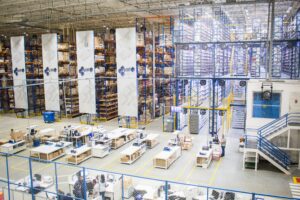In this blog, Amit Sachdeva looks at how advances in IoT and AI are set to revolutionise supply chain management and how goods get from A to B.
 Imagine eating at a restaurant where the diners, waiting staff and kitchen couldn’t communicate with each other at all times. It’d be chaos, wouldn’t it? Orders would end up at the wrong tables, dishes would go cold, and some people would probably end up getting nothing to eat at all. Even if just one part of the process was affected the results would be disastrous. Customers would walk out, a mountain of food would get chucked away and the amount of money being wasted would soon cause the place to go out of business.
Imagine eating at a restaurant where the diners, waiting staff and kitchen couldn’t communicate with each other at all times. It’d be chaos, wouldn’t it? Orders would end up at the wrong tables, dishes would go cold, and some people would probably end up getting nothing to eat at all. Even if just one part of the process was affected the results would be disastrous. Customers would walk out, a mountain of food would get chucked away and the amount of money being wasted would soon cause the place to go out of business.
What can we learn from our calamitous canteen? That a chain is no stronger than its weakest link, whether it’s made of restaurant staff or a combination of producers, warehouses, logistics companies and vendors. It only needs one part of the sequence to fail or underperform and the whole thing can be jeopardised.
Logistics’ transformation journey
With the rise of digital transformation, shipping companies, freight forwarders, road hauliers and related supply chain companies are increasingly using data to inform and communicate how they manage their businesses.
“When transporting anything from A to B, the more you know about the process from start to finish the better.”
It allows companies to improve their operations in multiple areas, including visibility, planning and efficiency, and customer service. More sophisticated connectivity enables access to real-time information on the status of shipments and inventories and allows businesses to source the most cost-efficient transport options and plan the best routes.
In the past, once a shipment had started on its journey, opportunities to track its condition and progress were limited, with cargoes spending the majority of their time in blind-spots, but with the capabilities offered by connected vehicles and sensors on pallets and containers, both customers and suppliers can keep track of exactly where their consignments are at every step. Especially in the context of Just-in-Time deliveries, real-time access to accurate information is paramount.
“Being able to tell your customers exactly where your products have been and when, right down to the minute, could also become a real point of differentiation between one business and another.”
 This doesn’t just mean recipients know when to expect deliveries, it can have a huge impact on how they manage what’s coming and going. When shipping food or perishable goods, shipments must be carefully handled at every stage to ensure they don’t get spoiled. If one arrives unexpectedly and the receiver doesn’t have the capacity to deal with it straight away the cargo can be put at risk.
This doesn’t just mean recipients know when to expect deliveries, it can have a huge impact on how they manage what’s coming and going. When shipping food or perishable goods, shipments must be carefully handled at every stage to ensure they don’t get spoiled. If one arrives unexpectedly and the receiver doesn’t have the capacity to deal with it straight away the cargo can be put at risk.
Not just getting from A to B
With the rise of IoT, logistics companies can also provide insight into the condition of cargoes throughout the journey, ensuring that their integrity is maintained and helping to avoid any nasty surprises on arrival. With every step of the chain being monitored on a granular level and in real time, this can help to limit waste, optimise inventories, reduce operating costs and maximise profits. 5G will only make this more accessible for more businesses and increase the number of vehicles and hubs in the wider IoT ecosystem that can communicate with each other.
Additionally, as more companies embrace the opportunities offered by technologies such as artificial intelligence (AI) and machine learning, many supply chain processes will be automated further, and demand will be calculated without any human involvement at all. Amazon owns a patent on predictive shipping, which will use analytics to anticipate demand and start the process before items have even been ordered.
“Products will be shipped to distribution centres in regions where they’re expected to be needed and diverted to specific areas when the orders come in, shortening the overall fulfilment time significantly.”
So, in the not-too-distant future, the shipping process will be able to predict demand in advance and start products on their journey in anticipation.
 Increased automation of the supply chain will also see the proliferation of robots, particularly in warehouses where loading and unloading can be done more quickly and with less opportunity for errors. According to Deloitte, 88% of supply chain professionals think that robotics and automation will allow organisations to manage risk and improve predictability. Eventually, this will also extend to the actual driving, as autonomous trucks begin to replace traditional haulage vehicles, with AI drivers that won’t be constrained by a maximum number of hours they can spend behind the wheel.
Increased automation of the supply chain will also see the proliferation of robots, particularly in warehouses where loading and unloading can be done more quickly and with less opportunity for errors. According to Deloitte, 88% of supply chain professionals think that robotics and automation will allow organisations to manage risk and improve predictability. Eventually, this will also extend to the actual driving, as autonomous trucks begin to replace traditional haulage vehicles, with AI drivers that won’t be constrained by a maximum number of hours they can spend behind the wheel.
With the logistics industry also likely to come under increased scrutiny for its impact on the environment, digital transformation initiatives can help companies to minimise their carbon footprint by streamlining their processes.
These developments invariably involve many partners and various different technologies. All these innovations will be underpinned by reliable, borderless connectivity through a best-in-class global infrastructure, which will enable real-time access to data-enabled insights end-to-end. The impact it will have on user experience, supply chain agility and overall efficiencies in the logistics sector cannot be underestimated.
If you’re interested in other innovations affecting the vehicular industry, have a look at our blog exploring advances being made across the connected car lifecycle.
Transformational Hybrid SolutionsOur cloud-enablement services offer the best performance on your traffic-heavy websites or mission-critical applications.
Core NetworksTata Communications™ global IT infrastructure and fibre network delivers the resources you need, when and where you need them.
Network Resources
Unified Communications As A ServiceBreak the barriers of borders efficiently and increase productivity with Tata Communications’ UC&C solutions.
Global SIP ConnectEmpower your business with our SIP network and witness it grow exponentially.
InstaCC™ - Contact Centre As A ServiceCloud contact centre solutions for digital customers experience and agent productivity.
DIGO – Communications Platform as a ServiceDIGO is an in-network cloud communications platform, enabling you to power up converged contextual human-to-everything conversations globally.
Unified Communication Resources Case studies, industry papers and other interesting content to help you explore our unified communications solution better.
IoT SolutionsThe Internet of Things is transforming the way we experience the world around us for good. Find out more about our Internet Of Things related solutions here.
Mobility SolutionsTata Communications’ mobility services enable your enterprise to maintain seamless communication across borders, with complete visibility of cost and usage.
Mobility & IoT Resources
Multi-Cloud SolutionsWith enterprises transitioning to a hybrid multi-cloud infrastructure, getting the right deployment model that yields ROI can be a daunting task.
Cloud ComplianceCompliant with data privacy standards across different countries and is also designed to protect customers’ privacy at all levels.
IZO™ Cloud Platform & ServicesIZO™ is a flexible, one-stop cloud enablement platform designed to help you navigate complexity for more agile business performance.
Managed Infrastructure ServicesIntegrated with our integrated Tier-1 network to help your business grow efficiently across borders.
Cloud PartnersWe support a global ecosystem for seamless, secure connectivity to multiple solutions through a single provider.
Cloud Resources
Governance, Risk, and ComplianceRisk and Threat management services to reduce security thefts across your business and improve overall efficiencies and costs.
Cloud SecurityBest-in-class security by our global secure web gateway helps provide visibility and control of users inside and outside the office.
Threat Management - SOCIndustry-leading threat-management service to minimise risk, with an efficient global solution against emerging security breaches and attacks.
Advanced Network SecurityManaged security services for a predictive and proactive range of solutions, driving visibility and context to prevent attacks.
Cyber Security ResourcesCase studies, industry papers and other interesting content to help you explore our securtiy solution better.
Hosted & Managed ServicesTata Communications provide new models for efficient wholesale carrier voice service management. With our managed hosting services make your voice business more efficient and better protected
Wholesale Voice Transport & Termination ServicesYour long-distance international voice traffic is in good hands. End-to-end, voice access & carrier services which includes voice transport and termination with a trusted, global partner.
Voice Access ServicesTata Communication’s provide solutions which take care of your carrier & voice services, from conferencing to call centre or business support applications.
Carrier Services Resources
CDN Acceleration ServicesOur CDN Web Site Acceleration (WSA) solution helps deliver static and dynamic content, guaranteeing higher performance for your website.
CDN SecuritySafeguard your website data and customers’ information by securing your website from hacks and other mala fide cyber activities.
Video CDNDeliver high-quality video content to your customers across platforms – website, app and OTT delivery.
CDN Resources
Elevate CXIncrease customer satisfaction while empowering your service team to deliver world-class customer experience and engagement.
Live Event ServicesTata Communications’ live event services help battle the share if eyeballs as on-demand video drives an explosion of diverse content available on tap for a global audience.
Media Cloud Infrastructure ServicesTata Communications’ media cloud infrastructure offers flexible storage & compute services to build custom media applications.
Global Media NetworkTata Communications’ global media network combines our expertise as a global tier-1 connectivity provider with our end-to-end media ecosystem.
Use CasesUse cases of Tata Communications’ Media Entertainment Services
Remote Production SolutionsMedia contribution, preparation and distribution are highly capital-intensive for producers of live TV and video content, and their workflows are complex.
Media Cloud Ecosystem SolutionsThe Tata Communications media cloud infrastructure services offer the basic building blocks for a cloud infrastructure-as-a-service.
Global Contribution & Distribution SolutionsTata Communications’ global contribution and distribution solution is built to reduce capital outlay and grow global footprint.
Satellite Alternative SolutionsAs more and more consumers choose to cut the cord & switch to internet-based entertainment options, broadcasters are faced with capital allocation decisions.
LeadershipA look into the pillars of Tata communications who carry the torch and are living embodiment of Tata’s values and ethos.
Culture & DiversityHere at Tata Communications we are committed to creating a culture of openness, curiosity and learning. We also believe in driving an extra mile to recognize new talent and cultivate skills.
OfficesA list of Tata Communications office locations worldwide.
SustainabilityTata Communications adopts a holistic approach and harnesses the power of new-age technologies like 5G, IoT and AI to build a sustainable digital world.
FAQCheck out our FAQs section for more information.
BoardHave a look at our board of members.
ResultsFind out more about our quarterly results.
Investor PresentationsFollow our repository of investor presentations.
FilingsGet all information regarding filings of Tata communications in one place.
Investor EventsAll investor related event schedule and information at one place.
GovernanceAt Tata, we believe in following our corporate social responsibility which is why we have set up a team for corporate governance.
SharesGet a better understanding of our shares, dividends etc.
SupportGet all investor related contact information here.


